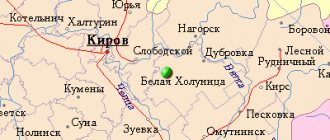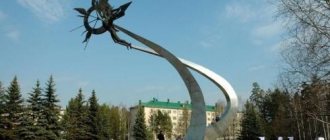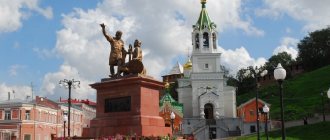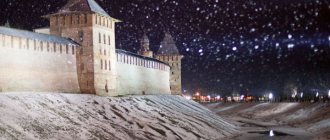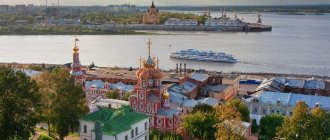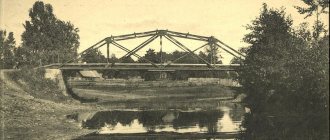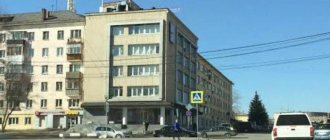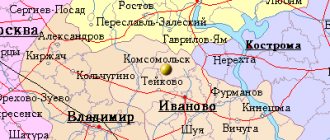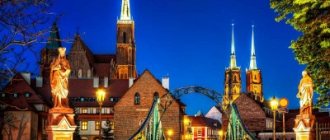Population
Employment
The working population is 35,000 people. Pensioners - 13 thousand people. As of September 1, 2003, in terms of unemployment, the Volodarsky district is in 17th place among other districts of the Nizhny Novgorod region, in terms of wage arrears per capita and overdue accounts payable - in 1st place.
Religious composition of the population
The Orthodox religion predominates in the area, including the Old Believers (Fedoseevskaya community). There are churches in Volodarsk, in the villages of Ilyinogorsk, Mulino, Smolino, Central, Reshetikha, Krasnaya Gorka, Novosmolinsky, Yuganets, Frolishchi (Holy Dormition Monastery of Florishcheva Pustyn), the villages of Starkov, Myachkov, an Old Believer prayer house in Volodarsk, a mosque in the village of Krasnaya Slide.
Medical institutions[ | ]
Medical care in the Volodarsky district is provided by the state budgetary healthcare institution of the Nizhny Novgorod region “Volodarskaya Central District Hospital.
Emergency medical care
carried out by the emergency medical care service of the Volodar Central District Hospital.
Outpatient care
appears in 5 clinics (Volodarskaya, Ilyinogorskaya, Reshetikhinskaya, Yuganetskaya, Frolishchenskaya), 4 medical outpatient clinics (Smolinskaya, Novosmolinskaya, Mulinskaya, Tsentralny village), 7 medical and obstetric centers (Myachkovo, Zolino, Ilyino, Ilyina Gora, Krasnaya Gorka, Inzhenerny , Mulino).
Inpatient care
is represented by 4 hospitals: Ilinogorsky, Reshetikhinsky, Yuganetsky, and Frolishchensky.
Treatment and diagnostic service
It is represented by clinical-biochemical and bacteriological laboratories, fluorographic and x-ray rooms, ultrasound rooms, FGDS, ECG, physiotherapy room, and mammograph. The hospital is equipped with modern equipment for x-ray diagnostics, functional, laboratory and ultrasound examinations.
Specialists from the Volodarsk Central District Hospital are always ready to provide comprehensive medical care to patients from all over the region. Every year, about 8.5 thousand patients receive medical care in the hospital. The district's outpatient clinics carry out more than 250 thousand visits per year.
Divisions:
- Volodarskaya polyclinic,
- Ilyinogorsk polyclinic,
- Ilyinogorsk hospital,
- Reshetikhinsky clinic,
- Reshetikhinsky hospital,
- Yuganetskaya polyclinic,
- Yuganetsky hospital,
- Frolishchensky hospital,
- general practitioner's office in the village of Frolishchi,
- Smolinsk medical outpatient clinic,
- Novosmolinsk medical outpatient clinic,
- Mulinskaya medical outpatient clinic,
- Central (Tsentralny village) medical outpatient clinic,
- paramedic and midwife station in the village of Myachkovo,
- paramedic and midwife station in the village of Zolino,
- medical and midwifery station in the village of Ilyino,
- first aid station in Krasnaya Gorka village,
- paramedic and midwife station in the village of Inzhenerny.
- paramedic and midwife station in the village of Mulino,
- medical and midwifery station in the village of Ilyina Gora,
- emergency medical service.
The main inpatient emergency and planned care is provided in the Ilyinogorsk hospital, where there are a 55-bed surgical, 40-bed neurological, 80-bed therapeutic department and a 10-bed intensive care unit, as well as 30 day hospital beds. In addition, a central emergency medical care substation is located in the village of Ilyinogorsk. There are 5 ambulance teams on duty in the area.
There is a nursing home for 180 people, a children's home for 70 people, and a boarding school for children with mental disabilities for 40 people.
There are 320 paramedical workers. There are 9 pharmacies in the area, of which 6 are private, in addition, there are 6 retail pharmacy outlets. The number of social assistance departments at home is 7.
Administrative and municipal structure
The Volodarsky district, within the administrative-territorial structure of the region, includes 11 administrative-territorial entities, including 1 city of district significance, 6 workers’ settlements and 4 village councils.
The Volodarsky municipal district, within the framework of the organization of local self-government, includes, respectively, 11 municipalities, including 7 urban settlements and 4 rural settlements.
Initially, until 2009, the territory of the Volodarsky district consisted of 1 city of regional significance, 6 workers’ settlements and 5 village councils. As part of the organization of local self-government in 2006-2009. 7 urban and 5 rural settlements were formed, respectively.
In 2009, the Myachkovsky village council, which was included in the Ilyinsky village council, was abolished.
Settlements
There are 32 settlements in the Volodarsky district.
Notes[ | ]
- from the point of view of the administrative-territorial structure
- from the point of view of the municipal structure
- ↑ 123456789101112
Nizhny Novgorod Region. Total land area of the municipality - ↑ 123456789101112131415161718192021
Population of the Russian Federation by municipalities as of January 1, 2022 (Russian). Date accessed: October 17, 2022. Archived October 17, 2022. - ↑ 12
Register of administrative-territorial entities, urban and rural settlements of the Nizhny Novgorod region dated January 15, 2019 - All-Union population census of 1989. Population of the USSR, RSFSR and its territorial units by gender (undefined)
. Archived from the original on August 23, 2011. - ↑ 1 2 3 4 5 6 7 8 9 10 11 12 13 14 15 16 17 18 19 20 21 22 23 24 25
All-Russian population census 2010.
Number and distribution of the population of the Nizhny Novgorod region (unspecified)
. Retrieved July 30, 2014. Archived July 30, 2014. - ↑ 123
Nizhny Novgorod Region. Estimated resident population as of January 1, 2008-2016 - Population of the Russian Federation by municipalities. Table 35. Estimated resident population as of January 1, 2012 (unspecified)
. Retrieved May 31, 2014. Archived May 31, 2014. - ↑ 1 2
Population of the Russian Federation by municipalities as of January 1, 2013.
- M.: Federal State Statistics Service Rosstat, 2013. - 528 p. (Table 33. Population of urban districts, municipal districts, urban and rural settlements, urban settlements, rural settlements) (undefined)
. Retrieved November 16, 2013. Archived November 16, 2013. - Table 33. Population of the Russian Federation by municipalities as of January 1, 2014 (unspecified)
. Access date: August 2, 2014. Archived August 2, 2014. - Population of the Russian Federation by municipalities as of January 1, 2015 (unspecified)
. Access date: August 6, 2015. Archived August 6, 2015. - Population of the Russian Federation by municipalities as of January 1, 2016 (Russian) (October 5, 2018). Retrieved May 15, 2022. Archived May 8, 2022.
- Population of the Russian Federation by municipalities as of January 1, 2022 (Russian) (July 31, 2017). Retrieved July 31, 2022. Archived July 31, 2022.
- Population of the Russian Federation by municipalities as of January 1, 2022 (Russian). Retrieved July 25, 2018. Archived July 26, 2022.
- Population of the Russian Federation by municipalities as of January 1, 2022 (Russian). Retrieved July 31, 2019. Archived May 2, 2022.
- Sergey Taranets.
Old Believers in the Russian Federation at the end of the 20th - beginning of the 21st centuries.
(Russian). www.rpsc.ru.
_ Official website of the Moscow Metropolis (September 4, 2018). Date accessed: February 29, 2022. - Register of administrative-territorial entities, urban and rural settlements of the Nizhny Novgorod region
- Law of the Nizhny Novgorod Region “On the administrative-territorial structure of the Nizhny Novgorod Region” (undefined)
. Access date: December 2, 2016. Archived December 9, 2016. - Law of the Nizhny Novgorod Region of June 15, 2004 No. 60-Z “On granting municipalities - cities, workers' settlements and village councils of the Nizhny Novgorod Region the status of urban and rural settlements"
- Law of the Nizhny Novgorod Region of August 28, 2009 No. 152-Z “On the transformation of municipalities - rural settlements of the Ilyinsky Village Council, Myachkovsky Village Council of the Volodarsky Municipal District of the Nizhny Novgorod Region and on amendments to certain laws of the Nizhny Novgorod Region”
Economy of the region
Industry
There are 12 manufacturing enterprises operating in the district, the main ones being:
- LLC "Bugrovskie mills" - flour production;
- LLC "Flour Mill "Volodarsky" - production of flour, semolina;
- LLC - production of zinc white, zinc oxide.
The volume of shipped goods of own production in manufacturing industries in 2022 amounted to 4.6 billion rubles.
Agriculture
The agricultural sector is represented by the following enterprises:
- OJSC Agro - production of eggs, poultry meat, canned poultry;
- LLC "Mulinskoe fish farm" - cultivation of sturgeon fish;
- LLC "Sea of Milk";
- JSC SIP "Agro-Seima".
In total, there are 4 agricultural enterprises and 6 peasant (farm) enterprises in agriculture. The volume of shipped goods of own production in agriculture in 2022 amounted to 3.0 billion rubles.
Transport
Well developed by trains and buses to Dzerzhinsk and Mulino, Novosmolino.
Connection
A new digital telephone exchange with 4,000 numbers was built in Volodarsk, and broadband access and PON technology is actively developing in the region.
see also
- Central (Nizhny Novgorod region)
- Reshetikha
- Frolishchi
- Gorokhovetsky artillery range
- Mulino
- Novosmolinsky (village)
| : Incorrect or missing image | To improve this article it is desirable:
|
Culture and education
Educational institutions:
The number of children in preschool educational institutions is 214 people, the number of places in preschool institutions is 2779.
The number of preschool children from 0 to 1 year is 42,430 people, from 1 to 7 years - 873,250 people.
The total number of students in educational institutions is 6656 people. There are 15 secondary schools in the area, including 3 in Volodarsk.
Also in the Volodarsky district there are:
- 5 adolescent rehabilitation centers (day care);
- 19 preschool institutions.
Culture and sports:
The area has:
- 1 museum center;
- 3 sports and health centers;
- 4 stadiums;
- 4 art schools;
- 6 art schools;
- 13 music schools;
- 13 sports complexes;
- 14 libraries;
- 26 public organizations, of which 17 are trade unions;
- 35 club institutions;
- youth, “Sambo” and others;
- society of hunters and fishermen.
The district newspaper “Znamya” is published in the region, periodically - once a week, 52 editions per year.
History of the Bugrov House
A little to the side, surrounded by greenery, is Bugrov’s mansion. It is impossible not to see such beauty - it can be seen from afar. We missed a little - we took to the right and lengthened the path, driving to the center through another crossing, but it is basically impossible to get lost here - all roads lead to Bugrov’s “mansion”, and we would also add - to “Bugrovskaya Square”.
Well, it would be very fair to call it that way. Well, judge for yourself, the entire complex of buildings in the city center was erected through the efforts of Nikolai Aleksandrovich Bugrov, and at his own expense! The famous Nizhny Novgorod Old Believer merchant, grain industrialist and philanthropist began building mills in Volodarsk in the second half of the 19th century, being one of the first in Russia to introduce steam engines instead of water drives.
So: the buildings of the flour mill, a two-story stone dormitory for workers, where the administration is now located, a flour shop (also made of stone), in which shops still operate today - aren’t these attractions worthy of the attention of Nizhny Novgorod residents and guests of our glorious land?!
There is also a hospital and a number of other buildings that also appeared thanks to Bugrov. And this “gingerbread” tower... It’s like something out of a picture, although it experienced complete ruin: after the revolution, the interiors were looted, the ancient parquet was removed, the stove and staircase were dismantled, and the park was destroyed.
Only the remains of the linden alley were preserved, and most importantly, the building itself, which, by the way, had heating and a bathroom, which was thoroughly damaged, but was not completely destroyed. “Terem” was to some extent lucky: at first party and Soviet organizations were located here, then the district House of Pioneers moved into it, and, as you know, any house is alive as long as there are people in it.
Home
A “test drive” in the opposite direction no longer produces the indelible impression that we received when we first set foot on this “warpath.” What do we need off-road? We crack holes like nuts and boldly push our line along the roadsides. The minibus is shaking behind us. Yes, we don’t envy those in the salon. A military KamAZ truck is rushing towards us. This is his element. But the RAV4, as it turned out, is no slouch, and, surprisingly, we weren’t tired at all.
It was very comfortable for those who drove the entire journey: the seat is electrically adjustable and beautifully molded. The comrade in the back seat got completely lazy and stopped trying to use the steering wheel, admitting that he was fine there even without a steering wheel, that he hardly chatted on the bumps, and there was so much space that he could lie down, take a nap, and in general, feel at home.
Toyota RAV4 demonstrates a very moderate “appetite”, which is confirmed by the trip computer readings - on average we consume 8.7 liters per 100 kilometers. 20 liters is enough for us both ways, and that’s 740 rubles.
Results:
the road to Svetlye Lakes with a stop at Volodarsk and Frolishchi and back - approximately 220 km;
travel time - 10 hours;
excursion to Bugrov’s dacha - 350 rubles;
Lunch - 300 rubles.
Total per person - 473 rubles.
Considering that this was reconnaissance, the expenses were quite minimal. They will increase if you travel with an overnight stay and the obligatory barbecue, but not by much. In any case, there will be more impressions, and their quality will be richer. Both the soul and the body will rest. And you will recognize, understand and appreciate your car. We give the Toyota RAV4 5 points plus. How much will you set for your “swallow”, and for yourself too?
GC Toyota Center Nizhny Novgorod official dealer of Toyota in Nizhny Novgorod
Moskovskoe highway, 94 A (831) 275-43-34
st. Larina, 30 (831) 425-85-85
Text and photos: Polina Zimina, Alexander Sheronov
For any use of site materials, an active link to is required.
History of the Florishcheva Hermitage: on the border of three regions
It seems that fidgeting along the gullies will never end. This RAV4 doesn’t give a damn, and we, frankly, are tired of these monotonous repetitions of the same actions: brake to the floor, left steering wheel, right steering wheel, stop, gas, and again - on the brakes. It seemed like they couldn’t confuse the road, and it’s impossible: the village of Tsentralny is already behind us, we’re sticking to the main road. So it will be soon.
We get up at the crossing to take pictures of the car. Well, simply because we can’t figure out where in this wilderness a railroad came from that doesn’t have a single locomotive on it?! And there are no people visible, and the silence is somehow suspicious... Maybe this is also a military facility? But then why are we still free? Or is this the same non-electrified single-track Ilyino - Frolishchi, on which a diesel locomotive with one to three passenger cars ran until 2008?
It doesn't matter. The “piece of iron” is simply your landmark, confirming that you are moving towards a bright place on the right, albeit almost completely dead, road. But here they are, the domes! In fact, you can see it from afar!
About two hundred meters before the entrance to Florishchi something similar to an asphalt surface begins. The last major hole... Well, how can we not celebrate this event with a photographic camera? A photograph “for eternal memory” - as a reminder that before reaching the monastery, one must perform a feat, albeit small.
The day slowly drags on towards evening, but the sun is still scorching. There is not a soul on the streets of Frolishchi. Quietly on the border of the Nizhny Novgorod, Vladimir and Ivanovo regions, the junction of which adorns this village, located in the very center of a huge massif of Gorokhovetsky forests, Yaropolchesky and Mugreevsky pine forests.
Twenty streets, almost 1450 people. Where are they all? Perhaps time flows here somehow differently, slowly, or something. And the vanity seems to be blown away from us by a light breeze when we pass the gates of the Holy Dormition Florishcheva Hermitage. Women will be given long skirts and scarves upon entry, and men will be given trousers if they are wearing shorts. By the way, one of us needed “trousers,” as one of the locals put it, just like women’s clothing items.
Imagine lush, fabulous green grass, white walls, golden domes and blue sky. You can sit under the shade of trees, think about the eternal, go to a temple. And people come here, each for something of their own: the place is unique. We won’t go into a lot of interesting details; you’ll find out everything yourself when you arrive. Let's limit ourselves to just a few facts.
The ancient monastery was founded at the beginning of the 17th century, when hermits settled on Florishcheva Mountain, and the first was the elder Schemamonk Methodius. Florishcheva Mountain was an unusual place - many of the people who were here often heard a wondrous ringing sound, emanating as if from under the ground itself. That's why they built a monastery here.
The first rector of the monastery was the Monk Hilarion, who, at the request of Tsar Fyodor Alekseevich Romanov, was elevated to the rank of metropolitan. An iconic figure of his time, he was the last metropolitan of ordinary people who achieved high position solely through their spiritual exploits.
By decree of the king, who greatly respected Hilarion, instead of wooden churches and cells, stone ones were built here, and of such a size that, as they say, even the capital’s residents’ hats fell off when they lifted their heads to look at the crosses on the temples.
Here is a 49-meter bell tower with newly cast bells and a newly installed chime clock (chiming quarter hours and every hour). It was once the fourth tallest in Russia. Together with the huge five-domed cathedral in the name of the Dormition of the Blessed Virgin Mary, it was erected in just one year and consecrated in the presence of the Tsar himself on September 30, 1681.
Prince Boris Alekseevich Golitsin is buried on the territory of the monastery. For what reasons did the Kazan governor end up in the Florishcheva Hermitage? Who will say now... It is known that the prince took monastic vows here with the name Bogolep, donating many church valuables to the monastery, and at his own expense built a two-story building in the monastery. Here the monk Bogolep died and was buried at the altar of the Assumption Cathedral.
Needless to say, during the years of Soviet power the monastery was completely abandoned. But restoration work began, and in 2006 the temple in honor of the Life-Giving Trinity was rebuilt. In 2008, restoration work began on the Assumption Cathedral Church. The abbot's building has been restored, repair work is underway in the Peter and Paul Church, the treasury and singing buildings.
Toyota RAV4: suspension
You can drive at any speed, but preferably no more than 15 - 20, and in some places 0 kilometers per hour (first stop, then “crawl”). Therefore, on relatively flat areas, two hundred meters long, no more, we spur our brave RAV4 to 40 - 50 and a little more, in order to cheer up both it and ourselves, and at the same time get closer to our cherished goal. The 2.5-liter 180-horsepower engine, producing 233 Nm and operating in tandem with a 6-speed automatic transmission, easily allows you to make sharp and short dashes.
All that is required is to remain vigilant and slow down in front of the most terrible pits, of which there are plenty here. You can, of course, overshoot, but the car does not deserve such an attitude, although it is capable, it was clear, of taking over an obstacle in motion. We used the capabilities of the RAV4 by sixty percent, no more was required, or rather, he himself decided what to do at one time or another, and these moments changed, sometimes at breakneck speed.
Having crossed the next section along the side of the road, because the soil in that place turned out to be preferable to the former asphalt roadway, and having reached relatively intact concrete slabs, we give the gas, not seeing what’s next - grayness merges with grayness... And there are some kind of craters that you can’t get around. There is nothing left to do but slam on the brakes. The “stern” sharply pulls to the side, but the integrated dynamic control system, which can steer the rear axle, returns it to its place.
The restyled Toyota RAV4 has changed not only in appearance. And the matter is not limited to an expanded set of options: you will feel the main differences from the previous model only when you get behind the wheel, because Toyota engineers have worked thoroughly on the settings of the suspension elements.
It seems that everything is the same - McPherson in front, multi-link in the rear, but you feel the car even better: a little trick worked in the form of larger rear silent blocks, stiffer shock absorbers and “soft” springs. Thanks to this decision, the car, which was already attentive to the driver, became even more obedient. In addition to the fact that you no longer need to steer at high speed, you pass joints and small and medium-sized asphalt unevenness without noticing.
There’s not even a smell of such little things here, but we won’t be crawling through this virgin soil forever! We crawl, however, mentally - 10 percent of traction is present on the rear axle by default, but, if necessary, you can forcibly distribute the torque between the axles in a 50:50 ratio. This mode operates at speeds of up to 40 kilometers per hour, then everything depends on the will of the sensors that monitor the situation.
A little later, on a sandy and rather steep descent and ascent to one of the Svetlye lakes, this helped us a lot. We are finally and irrevocably convinced that the RAV4 is still a real crossover, which you can safely drive not only on the highway, but also on good off-road terrain, which is the “road” to Frolishchi.
